Contents
Panoptic Segmentation Overview
Panoptic Segmentation Challenges
Important Factors for Segmentation Tools
Panoptic Segmentation Tools
1. Encord
2. iMerit
3. Segments.ai
4. Kili
5. Superb AI
6. Mindkosh
7. SuperAnnotate
8. Hasty
9. Labelbox
Panoptic Segmentation Tools: Key Takeaways
Encord Blog
Panoptic Segmentation Tools: Top 9 Tools to Explore in 2025

While image classification and object recognition remain the mainstream computer vision (CV) tasks, recent frameworks also address image segmentation methods to handle more complex scenarios.
Enter panoptic segmentation: a CV task that merges the comprehensive understanding of semantic segmentation (categorizing each pixel into a class) with the precise object differentiation of instance segmentation (identifying individual object instances).
Since its inception in 2017, panoptic segmentation has rapidly gained traction, as evidenced by over 200 research papers. This indicates its potential to transform how machines perceive and interact with their environments.
This method is pivotal for applications requiring a detailed understanding of both 'stuff' (like sky, water, or grass) and 'things' (such as cars, animals, or people) in an image.
However, the leap to panoptic segmentation introduces complex challenges, including the need for precise, pixel-level annotations, handling the sheer computational demands of processing detailed images, and developing models that can effectively learn from such rich data.
This article introduces the essential considerations before adopting a panoptic segmentation tool and surveys the leading platforms in 2024. Our guide aims to assist you in selecting the most suitable solution for your vision systems, ensuring they can interpret complex environments with unprecedented clarity.
We also give an overview of the top panoptic segmentation tools, as listed below, to help you choose the best solution for the job.
- Encord
- iMerit
- Segments.ai
- Killi Technology
- Superb AI
- Mindkosh
- Super Annotate
- Hasty
- Labelbox
Panoptic Segmentation Overview
In computer vision (CV), image segmentation aims to label each pixel within an image to identify objects more accurately. The annotation method helps build computer vision models for use cases like self-driving cars, healthcare, and robotics.
The technique consists of semantic, instance, and panoptic segmentation tasks. Let’s quickly discuss each in more detail.
Semantic Segmentation
Semantic segmentation assigns a label to each pixel within an image. It aims to detect ‘stuff’ - regions with similar patterns - and distinguish between different entities in a single image.
For example, it will draw separate segmentation masks for people, cars, traffic lights, and trees in an image displaying objects on the road.
Instance Segmentation
Instance segmentation detects ‘things’ - countable objects - and distinguishes between each instance of the same object in an image. For example, instance segmentation will identify each person within an image as a separate entity, whereas semantic segmentation will assign the same class label to everyone in the image.

Semantic (left) vs Instance Segmentation (right)
Panoptic Segmentation
Panoptic segmentation combines semantic and instance segmentation to produce accurate pixel-level annotations for more complex computer vision applications. It detects ‘stuff’ and ‘things’ for a richer scene understanding by merging classification and detection algorithms.
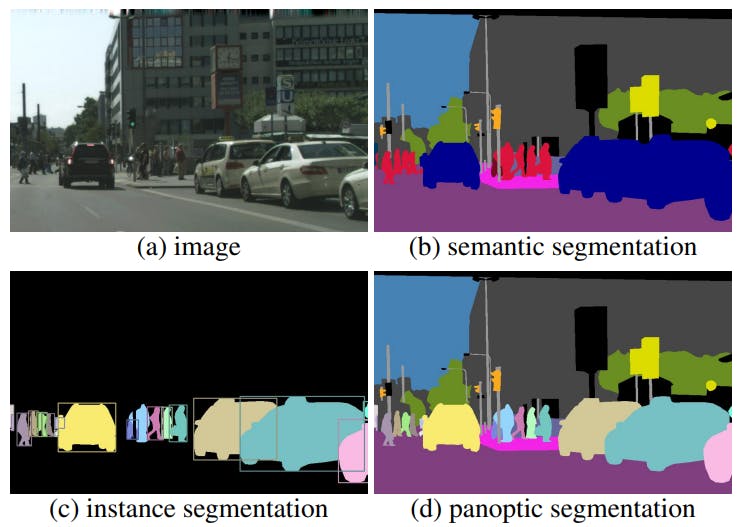
Semantic vs Instance vs Panoptic Segmentation
Panoptic Segmentation Challenges
While panoptic segmentation is a powerful technique to improve visual understanding, it poses multiple challenges due to the following reasons:
- Overlapping Objects: Segmenting overlapping objects is difficult as the algorithms cannot identify object boundaries to generate accurate masks.
- Image Quality: Low image quality makes detecting things and classifying stuff challenging due to blur, occlusion, and unclear shapes.
- Lack of Training Data: Building segmentation models requires extensive, high-quality training datasets to comprehensively understand everyday objects. Developing such models from scratch is tedious and costly.
Due to these issues, you must search for a suitable platform that offers pre-built segmentation frameworks and tools to efficiently label visual data of all types and formats through user-friendly interfaces.
Important Factors for Segmentation Tools
Investing in a segmentation platform is a strategic decision that requires careful analysis of the available solutions.
However, with so many platforms flooding the market, finding the best tool for the job becomes overwhelming.
So, this list below highlights the factors that will help you select the most suitable annotation tool based on your specific requirements.
- Annotation Methods: Multiple annotation methods, including bitmasks, polygons, bounding boxes, and key points, help you annotate and segment various data types and address complex labeling scenarios.
- Support for Multi-Modal Data: To ensure efficient data processing, support for images, sequences, videos, and point clouds is necessary.
- Scalability: Select a tool that can quickly scale up with minimal overhead. Consider its ability to manage large-scale projects and heavy workloads.
- Collaboration: Collaborative tools can streamline workflows by allowing teams to work on shared projects and speed up delivery.
- Automation: Tools with automated labeling techniques can boost annotation speed and quality.
- User Interface (UI): An easy-to-use interface allows you to use a platform to its full potential.
- Integrability: Integration with cloud storage platforms, plugins, and modeling frameworks improves functionality and lets you address domain-specific issues.
- Data Security: Ensure the tool complies with established international security standards to protect data privacy.
- Price: A labeling tool’s feature set must justify its cost by offering sufficient functionality in an affordable price range.
Panoptic Segmentation Tools
Considering the earlier segmentation challenges, businesses must invest in a robust image annotation platform with state-of-the-art (SoTA) segmentation functionality.
The list below provides an overview of the top panoptic segmentation tools ranked according to the abovementioned factors to help you with your search.
1. Encord
Encord is a data development platform for managing, curating and annotating large-scale multimodal AI data such as image, video, audio, document, text and DICOM files. Transform petabytes of unstructured data into high quality data for training, fine-tuning, and aligning AI models, fast.
- Encord Index: Unify petabytes of unstructured data from all local and cloud data sources to one platform for in-depth data management, visualization, search and granular curation. Leverage granular metadata filtering, sort and search using quality metrics, and natural language queries to explore all your data in one place.
- Encord Annotate: Leverage SOTA AI-assisted labeling workflows and flexibly setup complex ontologies to efficiently and accurately label computer vision/multimodal data for training, fine-tuning and aligning AI models at scale.
- Encord Active: Evaluate and validate Al models to surface, curate, and prioritize the most valuable data for training and fine-tuning to supercharge Al model performance. Leverage automatic reporting on metrics like mAP, mAR, and F1 Score. Combine model predictions, vector embeddings, visual quality metrics and more to automatically reveal errors in labels and data.
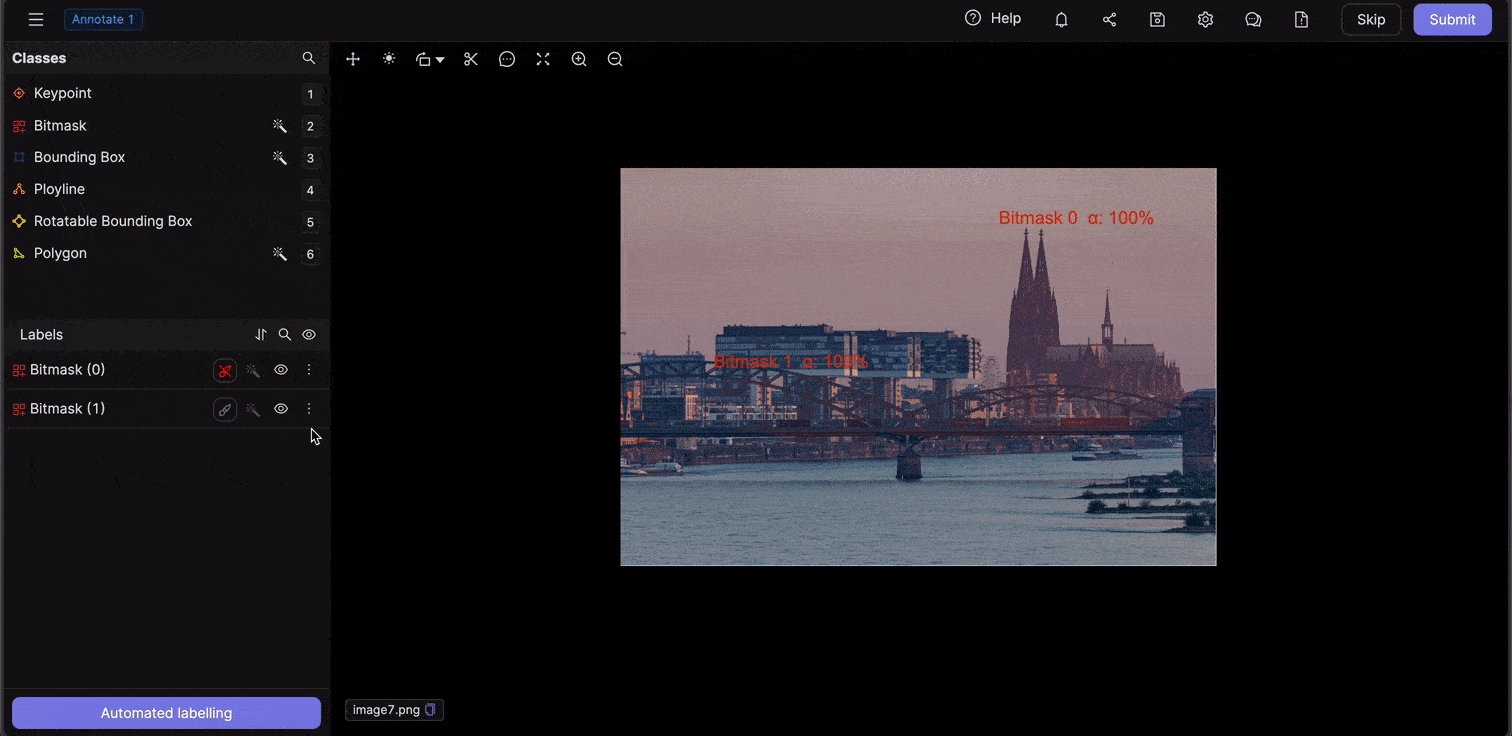
Key Features
- Supported Annotation Methods: Encord includes a bitmask annotation and lock feature to prevent segmentation and masks from overlapping. This helps with pixel-perfect accuracy for your segmentation tasks.
- Supported Data Types: The platform supports images, image sequences, videos, and Digital Imaging and Communications in Medicine (DICOM).
- Scalability: The platform allows you to upload up to 500,000 images (recommended), 100 GB in size, and 5 million labels per project. You can also upload up to 200,000 frames per video (2 hours at 30 frames per second) for each project. See more guidelines for scalability in the documentation.
- Collaboration: Users can quickly collaborate with their team members through shared annotation projects that let you create custom workflows for quality assurance steps.
- Automation - Segment Anything Model (SAM): Starting your annotation process can be time-consuming, especially for complex images. The SAM integration offers a one-click solution to create initial annotations, speeding up the annotation process with high accuracy.
- User Interface: Encord lets you surgically label overlapping objects at pixel level 5x faster with enhanced zooming functionality and image loading through the Label Editor UI. Also, the Python SDK lets experienced users perform segmentation tasks programmatically.
- Quality Metrics: You can assess annotation performance through robust panoptic quality metrics to quickly identify areas of improvement.
- Integrability: You can integrate with popular cloud storage platforms such as Microsoft Azure, Google Cloud Platform (GCP), Amazon Web Services (AWS), and Open Telekom Cloud OSS to import datasets.
- Data Security: The platform is compliant with major regulatory frameworks, such as the General Data Protection Regulation (GDPR), System and Organization Controls 2 (SOC 2 Type 1), AICPA SOC, and Health Insurance Portability and Accountability Act (HIPAA) standards. It also uses advanced encryption protocols to ensure adherence to data privacy standards.
Best for
- Teams looking for an enterprise-grade image and video annotation solution with advanced features to produce high-quality panoptic segmentation features.
Pricing
Encord has a pay-per-user pricing model with Starter, Team, and Enterprise options.
2. iMerit
iMerit is a data labeling tool that offers Ango Hub as its primary annotation platform for images, videos, and textual data. It features auto-labeling functionality with interactive tools for detecting object boundaries.
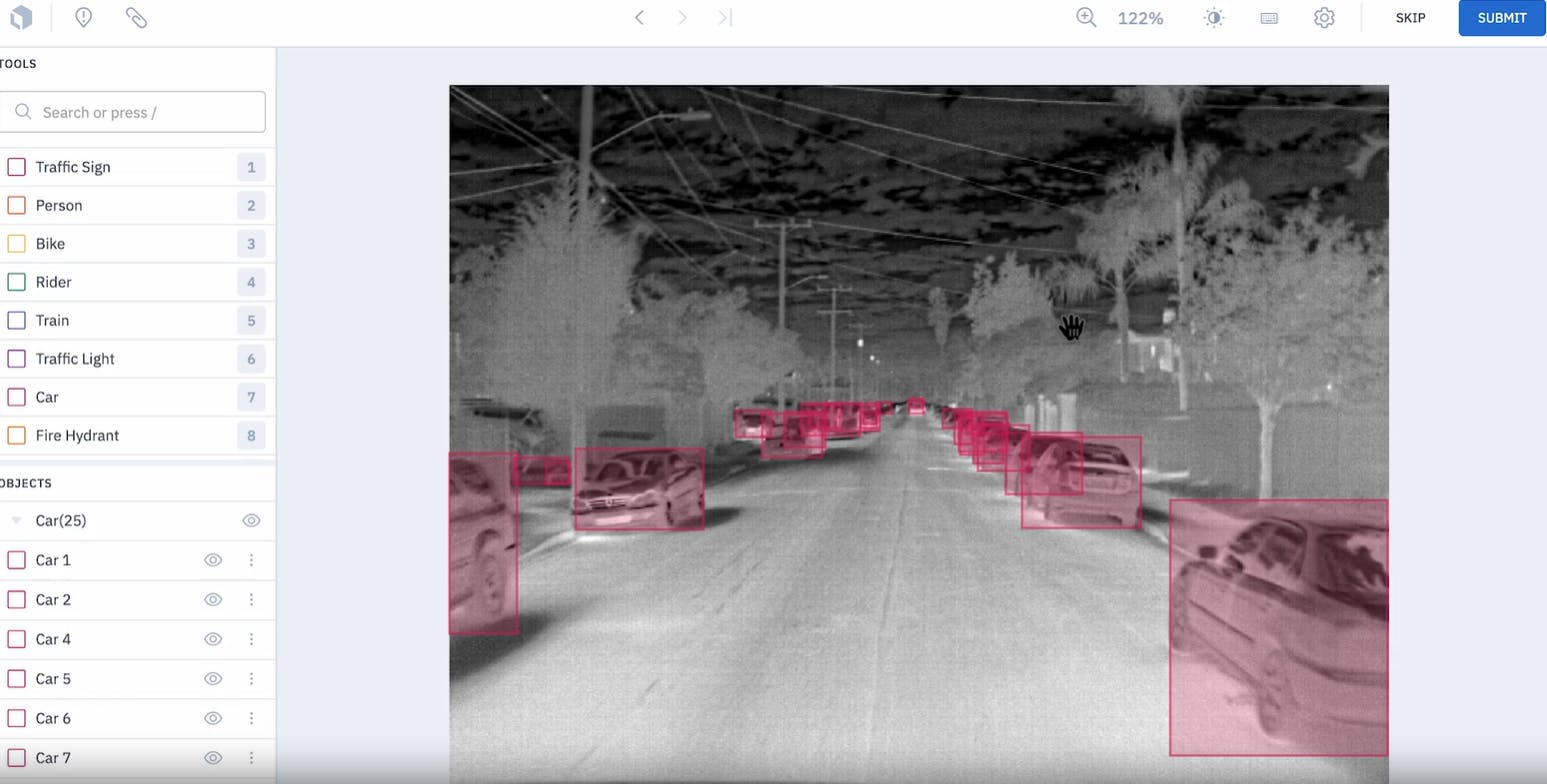
Key Features
- Annotation Methods: iMerit supports bounding boxes, polygons, polylines, key points, and segmentation. Users can draw polygons around objects to create segmentation masks.
- Supported Data Types: The platform supports images, videos, audio, textual, and DICOM data.
- Collaboration: iMerit lets you create shared projects and assign team members relevant roles, such as project owner, manager, annotator, and reviewer. It also allows for real-time troubleshooting, where annotators can directly notify project managers in case of issues.
- Automation: Plugins allow you to use pre-built models for data labeling.
- User Interface: The platform features an intuitive UI to create segmentation masks with holes using the polygon tool. It also features analytical reports to assess labeling performance against benchmarks for informed decision-making.
- Data Security: iMerit complies with the EU-U.S. Data Privacy Framework.
Best For
- Teams looking for a labeling solution to build CV applications for manufacturing and agricultural use cases.
Pricing
- Pricing is not publicly available.
3. Segments.ai
Segments.ai is a 3D labeling platform that allows you to annotate data from multiple sensors, such as cameras, radar, and LiDAR, through a unified interface. Its sensor fusion capabilities let users view 2D and 3D data simultaneously for better context.
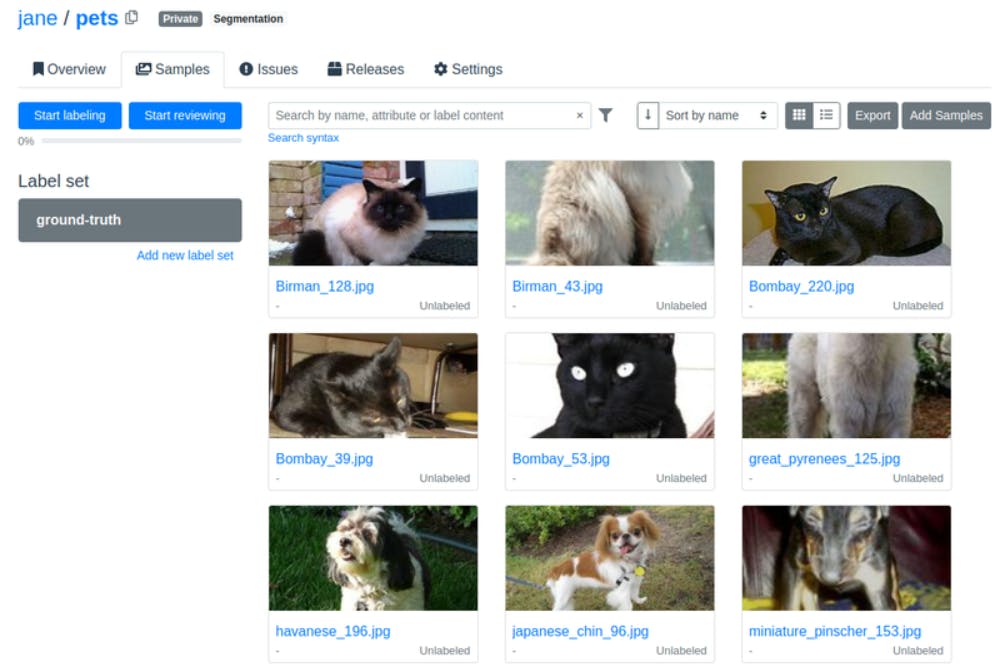
Key Features
- Annotation Methods: The tool supports segmentation, bounding boxes, cuboids, polylines, polygons, and key points.
- Supported Data Types: Segments.ai supports images and 3D point-cloud data.
- Collaboration: Users can add multiple collaborators to a project and assign them the roles of manager, reviewer, manager, or administrator.
- Automation: The platform comprises advanced segmentation models that let you create segmentation masks with a single click.
- User Interface: Segments.ai's UI is easy to navigate, and it uses multiple drawing tools, such as polygons and brushes, to specify segmentation masks. It also features a Python SDK to help you manage data programmatically.
- Data Security: Segments.ai complies with the ISO 27001 standards.
Best For
- Teams looking for a labeling solution for developing autonomous driving and robotics applications.
Pricing
- Segments.ai offers a Team, Scale, and Enterprise version.
4. Kili
Kili helps you label image and video data through batch processing and automated tools. It also offers evaluation tools to assess the performance of large language models (LLMs).
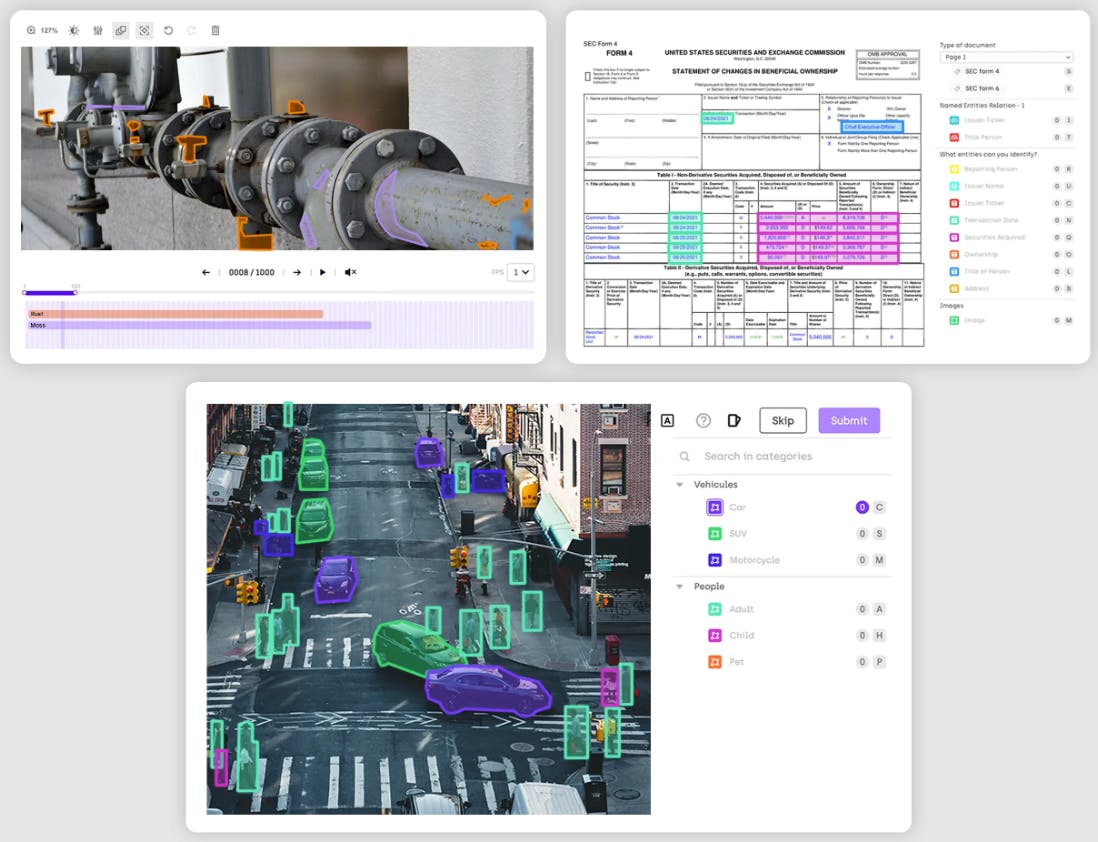
Key Features
- Annotation Methods: Kili supports bounding boxes, optical character recognition (OCR), cuboids, and semantic segmentation. It features an interactive click tool to adjust segmentation masks for different objects manually.
- Supported Data Types: The platform supports text, image, and video data.
- Collaboration: Users can add new members to labeling projects with relevant user roles.
- Automation: Kili allows you to use the Segment Anything Model (SAM) for high-quality segmentation and ChatGPT for pre-labeling textual data.
- User Interface: The platform's user-friendly interface for creating segmentation masks lets you define center points and adjust corners for more precision.
- Data Security: Kili is SOC 2-compliant.
Best For
- Teams looking for a solution to create training for LLMs.
Pricing
- Kili charges based on data usage.
5. Superb AI
Superb AI is an end-to-end solution for training and deploying AI models. It offers data curation and annotation features and the ability to use machine learning (ML) models for faster labeling.
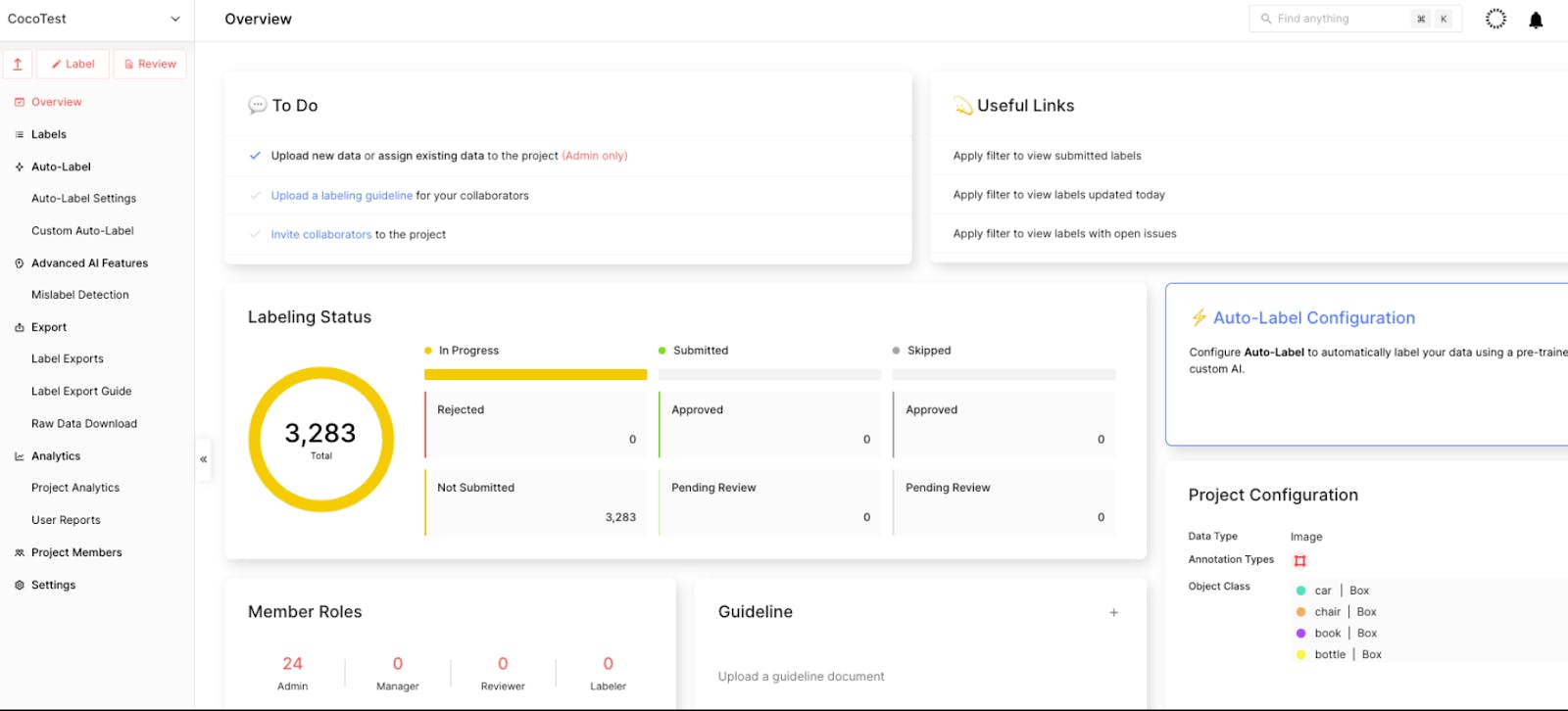
Key Features
- Annotation Methods: Superb Label supports bounding boxes, polygons, polylines, and cuboids. Users can draw polygons around objects to create segmentation masks.
- Supported Data Types: The platform supports image, video, and point cloud data.
- Collaboration: The tool features project management workflows that let you assign roles to team members for different labeling tasks.
- Automation: The Auto-Label features enable you to select pre-built models to annotate more than 100 objects.
- User Interface: The UI allows you to create precise segmentation masks through the polygon tool with features to define accurate vertices.
- Data Security: SuperbAI complies with the SOC and ISO 27001 standards.
Best for
- Teams looking for a solution to develop and deploy models.
Pricing
- Pricing is not publicly available.
6. Mindkosh
Mindkosh is a data labeling platform that offers AI-based annotation tools to label images, videos, and point cloud data. Its interactive segmentation functionality allows users to specify regions of interest they want to segment surgically.
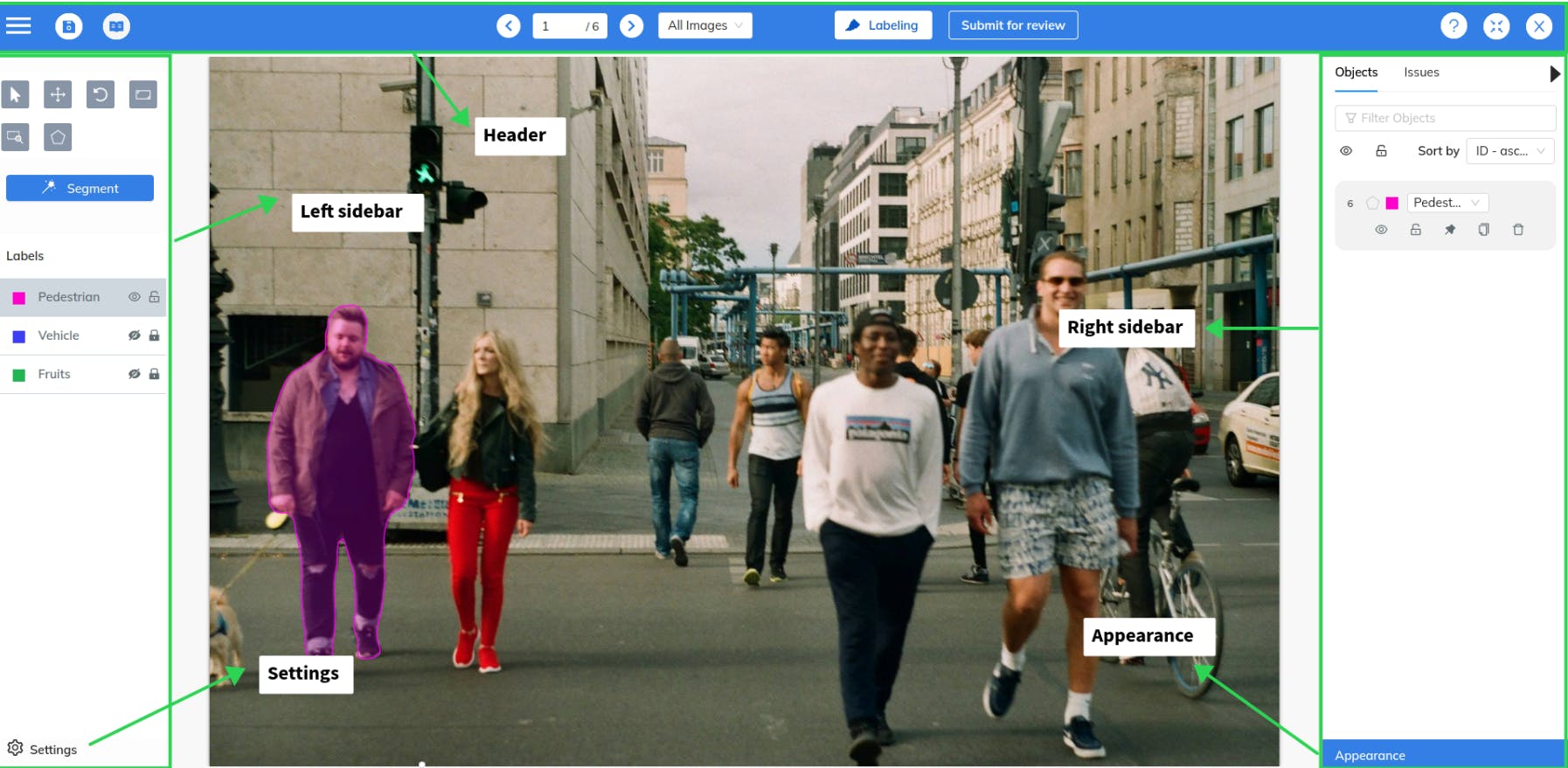
Key Features
- Annotation Methods: The platform supports bounding boxes, polygons, segmentation, cuboids, and key points.
- Supported Data Types: Mindkosh supports image, video, and point cloud data.
- Collaboration: Users benefit from shared workspaces and projects that let them assign labeling tasks to multiple users.
- Automation: The Magic Segment tool allows you to create segmentation masks automatically through a few clicks.
- User Interface: The interface comprises organized panels and a polygon tool to create segmentation masks.
- Data Security: Mindkosh uses the AWS infrastructure to host its application, making the platform compliant with all the security standards that AWS supports, including ISO 27001, SOC 1, and SOC 2.
Best For
- Teams looking for a segmentation tool at the beginner level.
Pricing
- Pricing is not publicly available.
7. SuperAnnotate
SuperAnnotate is a data management platform that lets you create training data for CV and natural language processing (NLP) tasks. It also helps you build automated pipelines through its built-in neural networks, webhooks, and Python SDK.
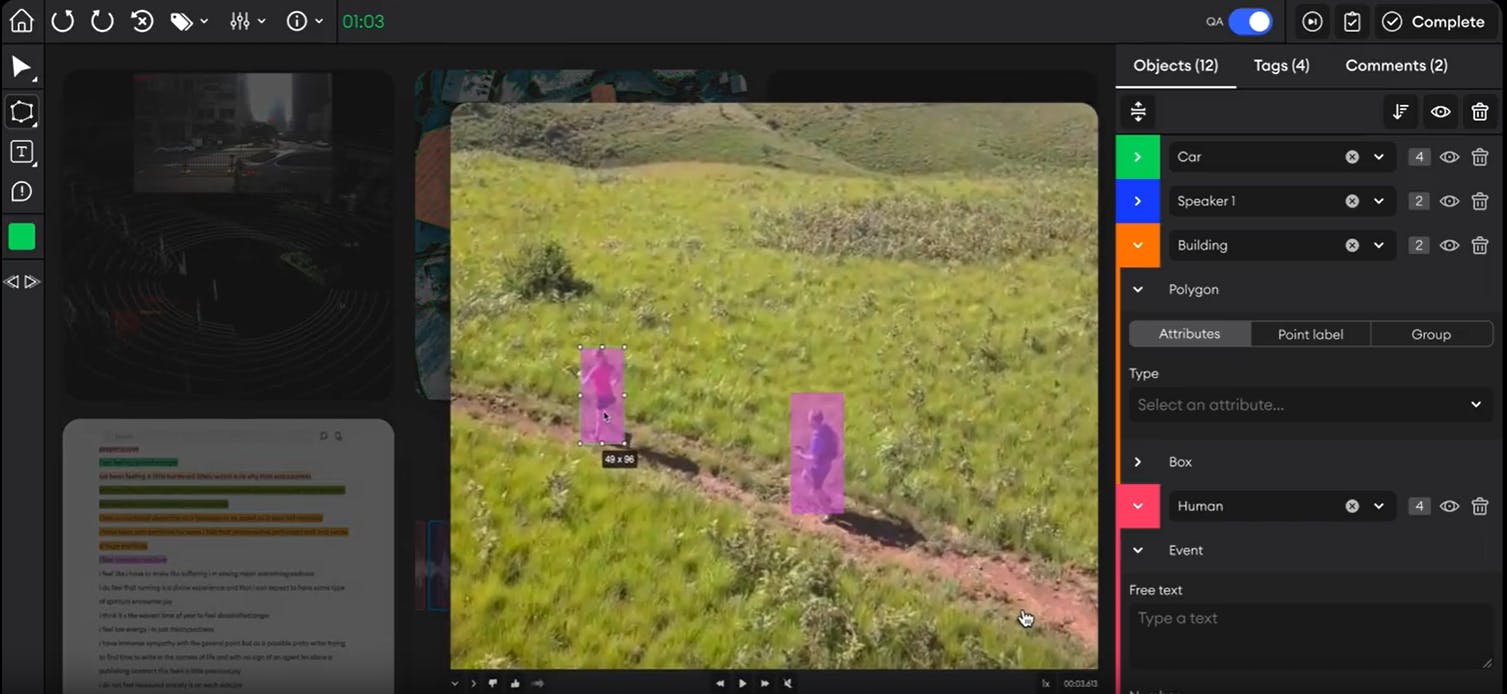
SuperAnnotate
Key Features
- Annotation Methods: SuperAnnotate supports bounding boxes, key points, and segmentation. It uses SAM to create accurate segmentation maps.
- Supported Data Types: The tool supports image, video, text, and audio data.
- Collaboration: The platform allows you to create shared projects and collaborate with stakeholders for task review and distribution.
- Automation: Users can fine-tune base models on custom training data to automate the labeling process.
- User Interface: SuperAnnotate features an interactive UI with easy-to-follow options, magic select, and polygon tools for quick segmentation.
- Data Security: SuperAnnotate complies with SOC 2, HIPAA, GDPR, and ISO 27001 standards.
Best For
- Teams looking for a solution that helps them implement MLOps pipelines.
Pricing
Pricing is not publicly available.
8. Hasty
Hasty is a lightweight annotation tool that uses AI models to label your data and manage quality assurance workflows. It features a model playground that lets you experiment with state-of-the-art deep-learning models to compare labeling output using different configurations.
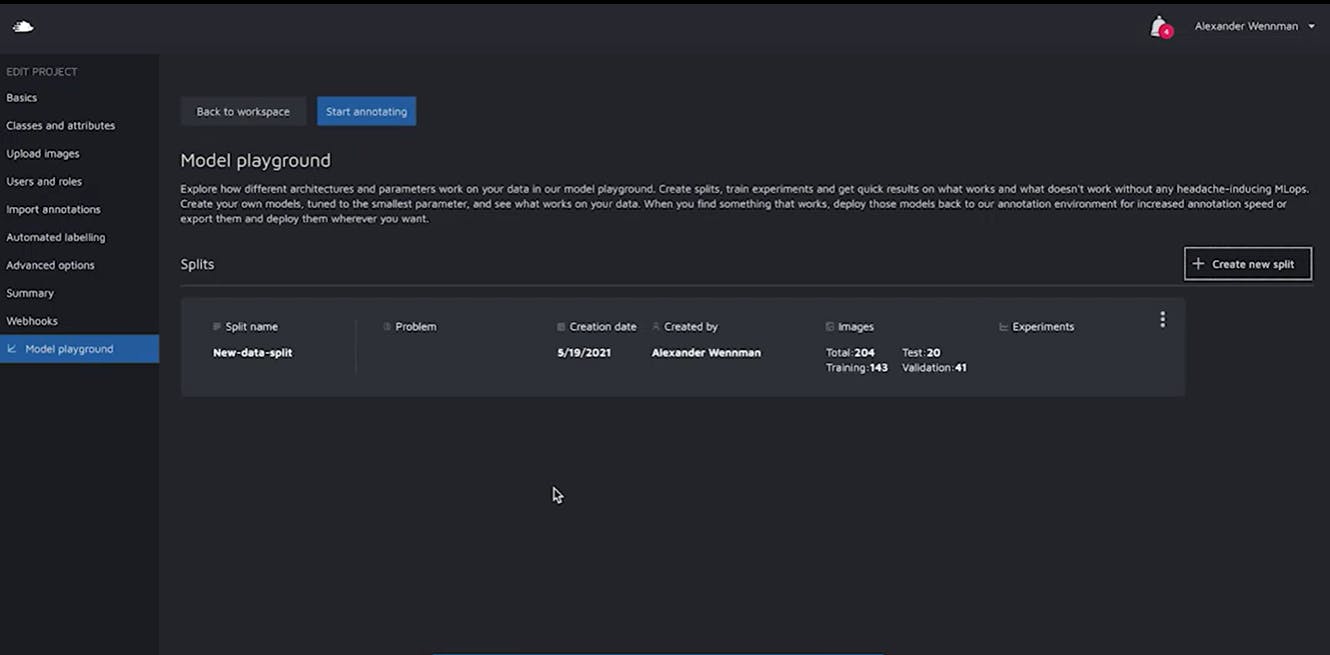
Key Features
- Annotation Methods: The tool supports object detection, image classification, and semantic and instance segmentation methods.
- Supported Data Types: Hasty supports image and video data.
- Scalability: The platform’s active learning pipelines make it suitable for labeling extensive datasets.
- Automation: Hasty features AI-assisted labeling and automated consensus scoring for faster annotation and error resolution.
- User Interface: It offers a user-friendly interface for creating models to annotate data.
- Data Security: Hasty complies with the ISO 27001 standards.
Best For
- Teams looking for a quick solution to label small-scale image datasets.
Pricing
- Pricing is not publicly available.
9. Labelbox
Labelbox is a data curation, annotation, and model evaluation platform. It features SoTA foundation models, reinforcement learning with human feedback (RLHF) functionality, and analytical reports to assess labeling quality.
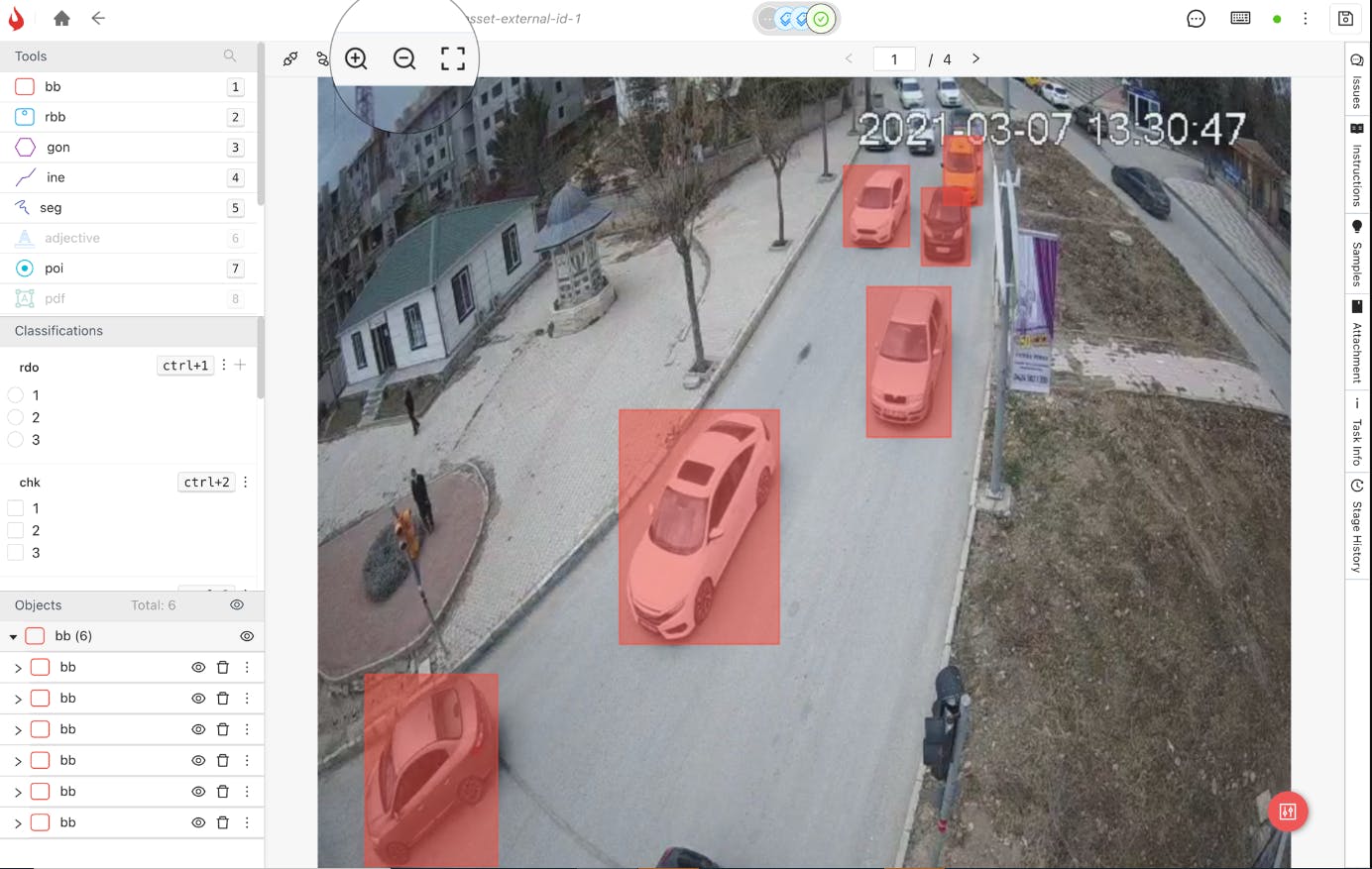
LabelBox
Key Features
- Annotation Methods: Labelbox supports bounding boxes, cuboids, polygons, polylines, key points, and segmentation masks.
- Supported Data Types: The platform supports images, videos, text, and audio data.
- Collaboration: Labelbox lets you create project-based groups with team members having specialized roles according to their expertise.
- Automation: The AutoSegment tool lets you create masks for individual objects to perform instance segmentation tasks.
- User Interface: The platform features an easy-to-navigate, no-code interface for labeling data and creating segmentation masks.
- Data Security: Labelbox complies with the GDPR, ISO 27001, SOC2, HIPAA, CCPA, DSS, NIST, and U.S. Government standards.
Best For
- Teams looking for a data management solution that integrates with the latest SOTA CV and LLM models.
Pricing
- The tool offers a Free, Starter, and Enterprise version.
Panoptic Segmentation Tools: Key Takeaways
As the field of computer vision expands to solve real-world problems, data annotation becomes challenging due to the rising volume and variety of data.
The trend calls for robust annotation and segmentation platforms to help organizations of all sizes efficiently manage labeling processes for extensive datasets with minimal overhead.
Below are some of the key points to remember regarding segmentation tools.
- Segmentation: Building segmentation modes from scratch is challenging due to poor data quality and lack of training data. Users need efficient tools to make the segmentation task easier.
- Factors to Consider: Advanced panoptic, instance, and semantic segmentation features. Support for multi-modal data and collaborative tools is essential when investing in a segmentation platform.
- Top Panoptic Segmentation Tools: Encord, iMerit, and Segments.ai are popular solutions offering automated segmentation functionality with robust collaborative features.
Explore the platform
Data infrastructure for multimodal AI
Explore product
Explore our products
- Panoptic segmentation is the simultaneous segmentation of objects (things) and backgrounds (stuff).
- Popular use cases include autonomous driving, surveillance and security, robotics, and augmented reality (AR).
- Challenges include a lack of training data, low image quality, occluded objects, and real-time segmentation.
- Popular datasets include COCO Minival, Mapillary Val, Cityscapes, and ADE20K Val.
- Top panoptic segmentation tools include Encord, iMerit, and Segments.ai.


